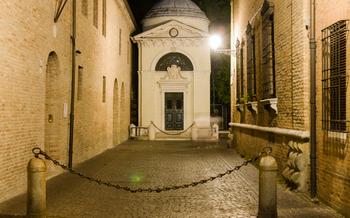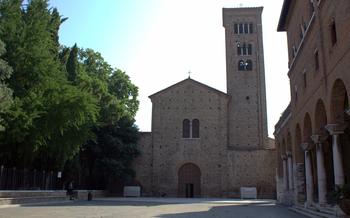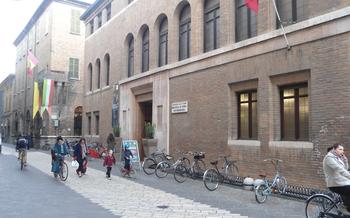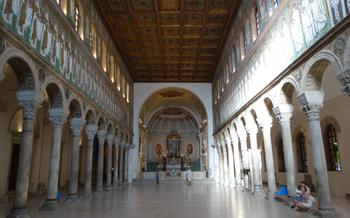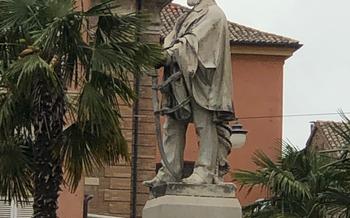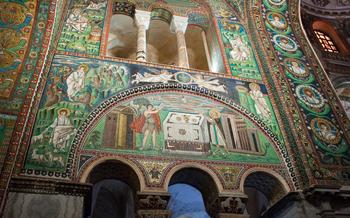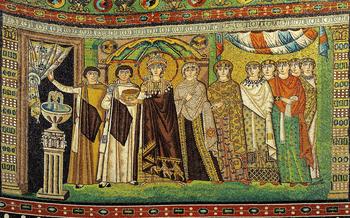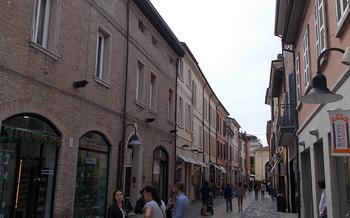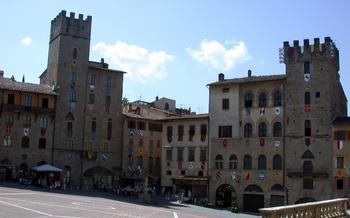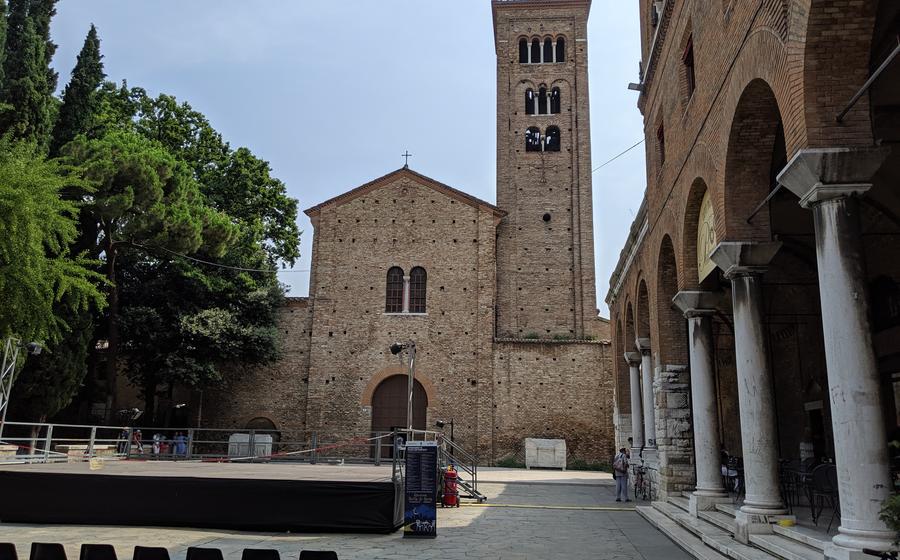
Basilica of San Francesco
- Introduction - The Allure of Ravenna and the Basilica of San Francesco
- Exploring the Basilica's Exterior - A Gothic Masterpiece
- Stepping Inside - Unveiling the Basilica's Interior Treasures
- The Apse - A Symphony of Color and Detail
- The Nave – A Showcase of Gothic Architecture
- The Transepts - Uncovering Hidden Chapels and Altars
- The Cloister - A Serene Retreat
- Tombs and Memorials - Honoring the Departed
- Guided Tours – Unveiling the Basilica's Stories
- Accessibility and Facilities for Visitors
- Planning Your Visit - Tips for an Optimal Experience
- Events and Celebrations - Witnessing the Basilica's Vibrancy
- Historical Context - Ravenna's Place in the Byzantine Empire
- Nearby Attractions - Exploring Ravenna's Treasures
- Insider Tip: Uncrowded Serenity at Sunrise
Introduction - The Allure of Ravenna and the Basilica of San Francesco
A Journey Through Time and Art
Nestled in the heart of the enchanting city of Ravenna, Italy, the Basilica of San Francesco stands as a testament to the city's rich history and artistic heritage. Ravenna, once the capital of the Byzantine Empire in Western Europe, was a thriving center of culture and power during the Middle Ages, leaving behind a legacy of awe-inspiring monuments and artistic treasures. Among these architectural wonders, the Basilica of San Francesco shines as a Gothic masterpiece.
The basilica, constructed in the 13th century, embodies the fusion of Gothic and Byzantine architectural styles. Its stunning facade, intricate frescoes, and impressive mosaics captivate visitors, transporting them back in time to an era of artistic and religious fervor. The basilica serves as a sanctuary of art and spirituality, inviting travelers to explore its hallowed halls and immerse themselves in its timeless beauty.
Exploring the Basilica's Exterior - A Gothic Masterpiece
The Basilica of San Francesco in Ravenna, Italy, stands as a testament to the grandeur of Gothic architecture. Its exterior facade is a symphony of pointed arches, intricate tracery, and sculpted figures that tell tales of biblical stories and historical events. The entrance, adorned with a rose window and flanked by slender columns, invites visitors into a world of spiritual beauty and artistic mastery.
The imposing bell tower, rising high above the basilica, is a beacon of faith and a symbol of the city's skyline. Its intricate carvings and delicate pinnacles create a sense of awe and reverence. The basilica's exterior is not merely a decorative shell but a visual representation of the deep faith and devotion that inspired its creation.
The historical context of the basilica's exterior design is rooted in the 13th century, a time of profound religious fervor and artistic innovation. The Gothic style, with its emphasis on light and height, was perfectly suited to express the spiritual aspirations of the Franciscan order, whose members sought to live in humility and simplicity while glorifying God through their devotion and architecture.
Stepping Inside - Unveiling the Basilica's Interior Treasures
Crossing the threshold of the Basilica of San Francesco, visitors are met with a breathtaking spectacle that transports them to a realm of artistic and spiritual wonder. The basilica's interior is a symphony of architectural elements, intricate frescoes, and sacred artifacts that collectively narrate the story of Christianity and the life of St. Francis of Assisi.
The basilica's interior layout is both spacious and imposing, with a nave flanked by two aisles that converge at the apse, creating a sense of depth and perspective. The nave is supported by rows of slender columns, their graceful arches reaching upwards to meet the ribbed vaults that form the ceiling. This Gothic architectural style, with its emphasis on height and light, creates a sense of awe and reverence within the sacred space.
The walls of the basilica are adorned with a series of stunning frescoes that depict scenes from the Bible and the life of St. Francis. These vibrant and expressive artworks, created by some of the most talented artists of the 14th century, bring the stories they depict to life and enhance the spiritual atmosphere of the basilica.
The Apse - A Symphony of Color and Detail
The apse of the Basilica of San Francesco is a masterpiece of Byzantine art, a breathtaking symphony of color and detail that transports visitors to another era. It is the focal point of the basilica's interior, a radiant jewel that draws the eye with its shimmering mosaics. The apse depicts scenes from the life of Christ, each tile meticulously arranged to create a narrative that unfolds before the viewer.
The central figure in the apse is Christ Pantocrator, the "ruler of all," depicted in majestic splendor, his hand raised in blessing. Flanking him are archangels, heavenly messengers with wings outspread. Below, the Virgin Mary and the Apostles stand in reverence, their faces expressing awe and devotion.
The mosaics are a testament to the skill and artistry of Byzantine craftsmen. The colors are vibrant, the lines are fluid, the expressions are lifelike. Each tessera, or tile, is like a tiny piece of a puzzle, fitting together to create a larger-than-life image that fills the apse with light and wonder.
The biblical narratives depicted in the mosaics are a source of inspiration and contemplation for visitors. The stories of Christ's birth, crucifixion, and resurrection are brought to life, inviting the faithful to reflect on the mystery of faith.
The apse of the Basilica of San Francesco is a true masterpiece, a testament to the power of art to transcend time and space. It is a place of beauty, a place of peace, a place where the sacred and the sublime meet.
The Nave – A Showcase of Gothic Architecture
The nave of the Basilica of San Francesco in Ravenna is a splendid testament to the grandeur of Gothic architecture. As you step inside, your gaze is immediately drawn to the soaring vaulted ceilings, supported by slender columns that create a sense of awe-inspiring height and spaciousness. The nave exudes an atmosphere of both grandeur and serenity that is characteristic of Gothic style.
The walls of the nave are adorned with intricate frescoes and decorative elements that depict scenes from the Bible and the lives of saints. These exquisite artworks add to the visual richness and spiritual significance of the space. The nave's layout follows the traditional Gothic design, with a central aisle flanked by two side aisles, separated by rows of elegant columns.
The overall impression of the nave is one of harmony and balance. The ribbed vaults, pointed arches, and slender columns work together to create a cohesive and aesthetically pleasing space. The nave's design serves both functional and symbolic purposes. It allows for the efficient movement of large congregations during religious ceremonies while also conveying a sense of heavenly transcendence through its soaring architecture and intricate ornamentation.
The Transepts - Uncovering Hidden Chapels and Altars
The transepts of the Basilica of San Francesco, extending perpendicularly from the nave, offer a serene and contemplative space. The north transept houses the Chapel of the Blessed Sacrament, a sacred space dedicated to the Eucharistic adoration. Adorned with intricate frescoes and stained glass windows, the chapel exudes an aura of tranquility and devotion.
In contrast, the south transept is home to the Chapel of the Madonna del Popolo, a site of great historical significance. This chapel preserves a venerated image of the Virgin Mary, deeply revered by the local populace. Pilgrims and worshippers flock to this sacred space to seek solace and pay homage to the Madonna, creating a palpable atmosphere of devotion.
Beyond these chapels, the transepts also feature a series of altars, each dedicated to a specific saint or religious figure. These altars are adorned with exquisite paintings, sculptures, and other decorative elements, showcasing the artistic prowess of the medieval artisans who crafted them.
The transepts of the Basilica of San Francesco serve as a testament to the rich history and spiritual significance of this sacred edifice. They offer visitors a chance to explore hidden corners, discover forgotten stories, and immerse themselves in the profound religious traditions that have shaped Ravenna's cultural heritage.
The Cloister - A Serene Retreat
Tucked away beside the basilica's bustling nave, the cloister offers a tranquil refuge, inviting visitors to step into a realm of serene contemplation. Constructed in the 15th century, the cloister's architectural style echoes the Gothic grandeur of the basilica, featuring graceful arches supported by slender columns. In the center, a verdant garden flourishes, providing a splash of color and life against the backdrop of ancient stone.
Historically, cloisters served as places of retreat and contemplation for monks and religious communities. Here, in the cloister of San Francesco, one can almost sense the echoes of whispered prayers and quiet footsteps that have graced these hallowed grounds for centuries. It was a place where monks would gather for prayer, meditation, and study, finding solace and inspiration within the cloister's peaceful embrace.
Tombs and Memorials - Honoring the Departed
Within the hallowed halls of the Basilica of San Francesco, numerous tombs and memorials stand as testaments to the lives of those who have passed. Among them, the tomb of Guido da Polenta, the former lord of Ravenna, is a poignant reminder of his rule and the city's rich history. The monument, crafted from Carrara marble, features intricate carvings that depict scenes from his life, immortalizing his legacy within the basilica's sacred space.
Other notable tombs include those of Ostasio I da Polenta, another former lord of Ravenna, and his wife, Francesca da Rimini. Their tragic love story, immortalized in Dante's Divine Comedy, adds a layer of romance and intrigue to the basilica's history. Visitors can also pay their respects at the tomb of Dante's daughter, Beatrice, who found her final resting place within the basilica's walls.
These tombs and memorials serve as a poignant reminder of the lives that have shaped Ravenna's history, transforming the basilica into a repository of memories and emotions. As visitors wander through the hallowed halls, they are invited to reflect on the lives of those who came before them, adding a personal touch to their exploration of this sacred space.
Guided Tours – Unveiling the Basilica's Stories
Enhance your visit to the Basilica of San Francesco by embarking on a guided tour. Knowledgeable guides offer insightful narratives, bringing the basilica's history, architecture, and artworks to life. Through their expert commentary, you'll uncover hidden stories, symbolism, and anecdotes that enrich your understanding of this sacred space. Guided tours provide a deeper level of engagement, allowing you to ask questions and gain a more comprehensive perspective of the basilica's significance. Whether you're a history buff, an art enthusiast, or simply curious to learn more, a guided tour will elevate your experience and leave you with lasting memories. Embrace the opportunity to delve into the depths of the Basilica of San Francesco and discover its captivating tales.
Accessibility and Facilities for Visitors
The Basilica of San Francesco welcomes visitors from all backgrounds and abilities. To ensure an inclusive and comfortable experience, the church provides several accessibility features for visitors with disabilities. Wheelchair ramps and elevators are strategically placed throughout the basilica, allowing easy access to various sections of the building. Accessible restrooms are also available within the premises.
In addition to accessibility features, the basilica offers essential facilities for visitors' convenience. Restrooms, conveniently located within the church, cater to the needs of travelers. For those seeking a moment of tranquility or reflection, the basilica provides a serene cloister that offers a tranquil retreat from the bustling city.
Planning Your Visit - Tips for an Optimal Experience
To ensure a fulfilling and enjoyable visit to the Basilica of San Francesco, it is recommended to arrive early in the morning or late in the afternoon to avoid the crowds and fully appreciate the basilica's serene atmosphere. Although there is no specific dress code, modest attire that covers the shoulders and knees is considered appropriate for visiting a religious site.
The basilica offers guided tours that provide insightful commentary on the history, architecture, and artworks within the church. These tours are an excellent way to delve deeper into the basilica's significance and uncover hidden stories that may not be apparent to the casual visitor. Visitors can inquire about guided tour availability at the basilica's information desk.
For visitors with disabilities, the basilica is accessible via a ramp located at the main entrance. Additionally, there are accessible restrooms available within the church premises. For further assistance or any specific accessibility requirements, it is advisable to contact the basilica's administration in advance.
Events and Celebrations - Witnessing the Basilica's Vibrancy
The Basilica of San Francesco is not just a historical monument but also a vibrant spiritual center that hosts a variety of religious festivals and events throughout the year. These celebrations offer a unique opportunity to witness the basilica's spiritual significance and connect with the local community.
One of the most important events is the annual Feast of San Francesco, held on October 4th. This festival honors the basilica's patron saint with a solemn mass, processions, and traditional festivities. The basilica is adorned with colorful decorations, and the air is filled with the sound of music and prayers.
During the Easter period, the basilica hosts special liturgies, including the Holy Week services and the Easter Vigil. These celebrations are particularly meaningful as they commemorate the resurrection of Jesus Christ and draw large crowds of worshippers.
Throughout the year, the basilica also organizes concerts, conferences, and exhibitions related to its history, art, and spirituality. These events provide visitors with an opportunity to delve deeper into the basilica's rich heritage and appreciate its cultural significance.
Attending one of these events is a wonderful way to experience the basilica's vibrant atmosphere and connect with its spiritual essence. Visitors can immerse themselves in the local traditions, witness the beauty of the basilica's rituals, and gain a deeper understanding of its role in the community.
Historical Context - Ravenna's Place in the Byzantine Empire
During the Byzantine era, Ravenna served as a significant port city and a crucial strategic hub for the empire. Its location on the Adriatic Sea made it a gateway for trade and military operations, connecting the empire's eastern and western territories. Ravenna's strategic importance was further solidified by its proximity to the Byzantine capital, Constantinople. As a result, the city became a favored residence for Byzantine officials and emperors, who contributed to its development and prosperity.
The Byzantine Empire's influence on Ravenna is evident in its art, architecture, and culture. The city's numerous churches and mosaics, including those found in the Basilica of San Francesco, are testaments to the deep Byzantine roots and the enduring legacy of the empire in Ravenna. These artistic treasures showcase the Byzantine aesthetic, characterized by vibrant colors, intricate designs, and a profound sense of spirituality.
Nearby Attractions - Exploring Ravenna's Treasures
Beyond the Basilica of San Francesco, Ravenna offers a wealth of other captivating landmarks and attractions that beckon for exploration. To fully immerse yourself in the city's rich history and cultural heritage, be sure to visit the following gems:
-
The Mausoleum of Galla Placidia: This 5th-century mausoleum is adorned with stunning mosaics that depict biblical scenes and symbolize the transition from life to eternity.
-
The Basilica of Sant'Apollinare Nuovo: Renowned for its breathtaking mosaics depicting scenes from the life of Jesus Christ, this 6th-century basilica transports visitors back in time.
-
The Museo Nazionale di Ravenna: This museum houses a collection of artifacts and artworks that provide a comprehensive overview of Ravenna's past, from the Roman era to the Middle Ages.
-
The Piazza del Popolo: The heart of Ravenna, this lively square is surrounded by historic buildings, including the Palazzo Comunale and the Torre dell'Orologio.
-
The Dante Alighieri's Tomb: Ravenna is the final resting place of the renowned poet Dante Alighieri, whose tomb is a popular pilgrimage site for literature enthusiasts.
To create a comprehensive itinerary, consider dedicating at least two days to exploring Ravenna. Combine visits to the Basilica of San Francesco and other religious sites with explorations of the city's museums and historical landmarks. Allow ample time to soak in the unique atmosphere of each attraction and discover the stories that lie within.
Insider Tip: Uncrowded Serenity at Sunrise
For an unforgettable and tranquil experience, consider visiting the Basilica of San Francesco at sunrise. As the sun's golden rays gently illuminate the basilica's exterior, you'll be greeted by a serene and almost ethereal atmosphere. With fewer crowds at this early hour, you'll have the opportunity to truly appreciate the basilica's beauty and intricate details without distractions. Capture the magic of the rising sun casting a warm glow on the basilica's facade, creating a picturesque moment that will stay etched in your memory. Embrace the tranquility of the early morning hours to connect with the basilica's spiritual essence and soak in its serene ambiance.
